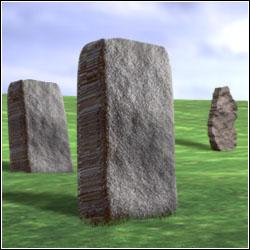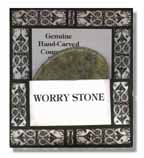 Everyone has heard of Stonehenge, the famous prehistoric stone monument where on Midsummer Night's Eve (June 21), Druids gather to pay homage to the mysteries of days gone past. The origins of Stonehenge have fuelled centuries of speculation about its symbolic meaning. Some view these huge megaliths as a sacred place where ancient religious sects worshipped gods and goddesses; others prefer to see celestial designs in the placement of the stones, and still others have a more temporal view, viewing Stonehenge and other megaliths like it as simply another beautiful, historic site. For those who are interested in the archaeology of standing stones and stone circles, there is plenty of information on the Internet to let you draw your own conclusions - temporal or spiritual.
The stone monuments vary in size, height and even appearance: some may be as big as a village or as small as ten feet across. They may contain hundreds of stones arranged in a grid like pattern, or they may be as few as four in a circle. And like modern-day graveyards, far too many are dilapidated beyond recognition. The most common similarity between all the stone circles and standing stones is that they consist of heavy rocks which have been lifted from one place to another to stand or lie in a particular configuration. The amount of energy and man hours it must have taken to build these monuments is simply mind-boggling and is part of the mystery that surrounds megaliths. How did these pre-historic peoples do it, and for what reason, are just two questions that come to mind when we think of the Herculean effort that must have gone into the task. The history of the oppression of these stone worshipping people is not very well documented. We do know that as early as the 5th century, the Church issued various edicts condeming the veneration of stones. In the 9th century, the Council of Nantes in France condemnded stone worship and ordered all stone monuments destroyed: failure to do so could result in death.
Other standing stones were associated with fertility and marriage. In the following account we hear of a young couple visiting the Stone of Odin, also known as Wodden's Stone, circa 1750: The parties agreed stole from the rest of their companions, and went to the Temple of the Moon, where the woman, in presence of the man, fell down on her knees and prayed the god Wodden (for such was the name of the god they addressed upon this occasion) that he would enable her to perform all the promises and obligations she had and was to make to the young man present, after which they both went to the Temple of the Sun, where the man prayed in like manner before the woman, then they repaired from this to the stone [known as Wodden's or Odin's Stone], and the man being on one side and the woman on the other, they took hold of each other's right hand through the hole, and there swore to be constant and faithful to each other. Unfortunately, the Stone of Odin no longer exists. It was destroyed in 1814 by an ignorant absentee Southern farmer who did not want trespassors on his property so he broke the stone and used it to build a cowhouse. His action so angered the locals that there were several unsuccessful attempts to burn down his house and property. Today, the rest of the megalith is virtually intact, save the Stone of Odin. It is open to the public. MORE about Scottish Megaliths on Gathering of the Clans: From Stone Henge to the Stones of Stenness: Megaliths in Scotland Part Two Those who want to further explore the subject of megaliths in Scotland should take advantage of the enormous amount of information available on the Internet. Below are links you can follow to find out more about the Standing Stones of Scotland and the amazing people who built and worshipped them thousands of years ago. MMJ, October, 1999 Links: Encarta Encylopedia Definition of Stonehenge Great pictures from The Stonehenge Organization Leon Fitt's Stone Circles Literary Sources on Megaliths from "Heathen Monuments" Discover Scottish Megaliths on The Stone Pages Time line from the Megalithic Pages |
Thursday, December 26th, 2019
Attention visitors: Tartans.com is back. Please note that this is a snapshot of the site as it existed nearly 20 years ago and you may encounter broken links; we are still combing through the site and correcting those as we find them. Please also note that some sections are currently not functional, primarily the discussion forums/clan chat boards.
|
** HOME - First Time Visitors - Glossary - - Contact Us ** Awards | Bibliography | Clan Calendar | Clan Chat | Clan Finder | History | Famous Scots | Genealogy | Great Hall of the Clans | Links | News and Features | Scots on the Net | Search | Site Map The Gathering of the Clans
Copyright 1995- Tartans.com - All Rights Reserved. |
 The megalithic monuments of Scotland date from the mid-Neolithic Period to
the late Bronze Age, about 3500 to 1000 BC. There are literally hundreds of
megaliths scattered throughout
The megalithic monuments of Scotland date from the mid-Neolithic Period to
the late Bronze Age, about 3500 to 1000 BC. There are literally hundreds of
megaliths scattered throughout  In 1410, the Bishop of Hereford issued a proclamation forbidding the
worship of stones and as recently as the 17th and 18th centuries, stones
were attributed with healing properties. These so called "healing stones"
were venerated as having special powers and many people visited them in
search for a cure. In one such ritual, small children were passed back and forth through large holes in standing stones for protection from illness. Some stones
were said to have soothing effects, a belief that has been passed down
through the millenia and still exists today in the form of small hand-held
worry stones which allegedly soothe and calm the person who handles
them.
In 1410, the Bishop of Hereford issued a proclamation forbidding the
worship of stones and as recently as the 17th and 18th centuries, stones
were attributed with healing properties. These so called "healing stones"
were venerated as having special powers and many people visited them in
search for a cure. In one such ritual, small children were passed back and forth through large holes in standing stones for protection from illness. Some stones
were said to have soothing effects, a belief that has been passed down
through the millenia and still exists today in the form of small hand-held
worry stones which allegedly soothe and calm the person who handles
them.